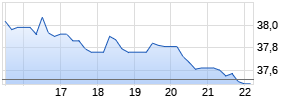
TreeHouse Foods, Inc. Reports Second Quarter 2016 Results
PR Newswire
OAK BROOK, Ill., Aug. 4, 2016
OAK BROOK, Ill., Aug. 4, 2016 /PRNewswire/ -- TreeHouse Foods, Inc. (NYSE: THS) today reported second quarter GAAP earnings of $0.27 per fully diluted share compared to $0.72 per fully diluted share reported for the second quarter of last year. The Company reported adjusted earnings per fully diluted share in the second quarter of $0.54 compared to $0.66 in the second quarter of the prior year, excluding the items described below.
The Company's 2016 second quarter results included five items noted below that, in management's judgment, affect the assessment of earnings. The first item was a $0.27 per share expense for product recall costs associated with the sunflower seed recall. The second item was a $0.08 per share expense for acquisition, integration, and related costs. The third item was a $0.05 per share expense for restructuring and facility consolidation costs. The fourth item was a $0.03 per share gain for mark-to-market adjustments. The final item was a $0.10 per share gain reflecting the tax impact of the aforementioned adjusting items.
| ITEMS AFFECTING DILUTED EPS COMPARABILITY: | Three Months Ended | | Six Months Ended | ||||
| | June 30, | | June 30, | ||||
| | 2016 | | 2015 | | 2016 | | 2015 |
| | (unaudited) | | (unaudited) | ||||
| | | | | | | | |
| Diluted EPS per GAAP | $ 0.27 | | $ 0.72 | | $ 0.22 | | $ 1.13 |
| | | | | | | | |
| Product recall costs | 0.27 | | - | | 0.27 | | - |
| Acquisition, integration, and related costs | 0.08 | | 0.01 | | 0.83 | | 0.05 |
| Restructuring/facility consolidation costs | 0.05 | | - | | 0.13 | | 0.01 |
| Mark-to-market adjustments | (0.03) | | (0.04) | | 0.06 | | (0.06) |
| Foreign currency (gain) loss on re-measurement of intercompany notes | - | | (0.06) | | (0.12) | | 0.19 |
| Tax impact on adjusting items | (0.10) | | 0.03 | | (0.36) | | (0.07) |
| | | | | | | | |
| Adjusted EPS | $ 0.54 | | $ 0.66 | | $ 1.03 | | $ 1.25 |
"We continue to progress in accordance with our plans for the year and our second quarter results represent further sequential improvement," said Sam K. Reed, Chairman, President and Chief Executive Officer. "Total Company revenue was up significantly due to the Private Brands acquisition. Volume/mix grew 4% in North American Retail Grocery, representing one of our best quarters in many years. Our operating results continue to show steady improvement, as we focus on customers, categories, consumers, and organizational capabilities."
"The detailed integration of legacy TreeHouse and Private Brands is well underway, and we are gaining momentum," continued Mr. Reed. "I'm pleased to report that we completed a virtually flawless integration of the acquired condiments business onto the TreeHouse SAP system in early July, linking seven product categories and eleven plants that serve over 500 customers. The work that is being undertaken across the organization to establish standardized processes, organizational structures, functional responsibilities and reporting relationships is extraordinary and is a testament to the robust level of collaboration within our organization."
Net sales for the second quarter totaled $1,541.4 million compared to $759.2 million last year, an increase of 103.0%, due to the inclusion of business from the acquisition of the private brands operations of ConAgra Foods, Inc. ("Private Brands") and favorable volume/mix, primarily in the North American Retail Grocery segment, partially offset by lower pricing and unfavorable Canadian foreign exchange. Compared to the second quarter of last year, sales in the second quarter of 2016 for the North American Retail Grocery segment increased 120.2%; sales for the Food Away From Home segment increased 27.5%; and sales for the Industrial and Export segment increased 84.3%. During the second quarter of 2016, the Company announced a recall of certain products that reduced net sales by $9.9 million, which was not allocated to the segments. The Company expects to be fully indemnified for the amount.
Reported gross margins were 17.2% in the second quarter of 2016 compared to 19.9% in the second quarter of the prior year. The decrease in gross margin as a percent of net sales was primarily due to lower margin products from the Private Brands acquisition, which contributed 160 bps toward the decline. Also contributing to the decrease was the year-over-year impact of unfavorable foreign exchange and increased operating costs, which more than offset the impact of favorable input costs. Included in cost of sales was approximately $5.3 million of costs related to the product recall in the second quarter of 2016 as compared to none in the prior year.
Selling, distribution, general and administrative expenses increased $101.3 million in the second quarter of 2016, or 124.8%, to $182.4 million. As a percentage of net sales, these costs increased from 10.7% in the second quarter of 2015 to 11.8% in the second quarter of 2016. Included in selling, distribution, general and administrative expenses are approximately $4.6 million and $0.6 million of acquisition and integration costs for the second quarters of 2016 and 2015, respectively. After considering the impact of acquisition and integration costs in each year, selling, distribution, general and administrative expenses as a percent of net sales increased to 11.5% of net sales in the second quarter of 2016, compared to 10.6% in the second quarter of 2015, primarily due to the general growth of the business and higher incentive compensation as compared to the prior year. In the prior year, the Company reduced incentive compensation due to operating results.
Amortization expense increased to $28.5 million in the second quarter of 2016, compared to $15.6 million in 2015, primarily due to the Private Brands acquisition.
Other operating expense increased by $3.2 million in the second quarter of 2016, compared to 2015. The increase was due to higher costs associated with restructurings that were announced in recent quarters with respect to the Company's closure of the City of Industry, California; Ayer, Massachusetts; Azusa, California; and Ripon, Wisconsin facilities.
Other expense was $29.4 million in the second quarter of 2016, an increase of $22.7 million from $6.7 million in the same period last year. Net interest expense increased $19.7 million in the second quarter of 2016 versus the prior year due to higher debt levels and higher average interest rates resulting from financing the Private Brands acquisition. The Company recorded a gain on foreign currency exchange of $0.7 million in the second quarter of 2016 compared to a gain of $2.4 million in the prior year due to fluctuations in currency exchange rates between the U.S. and Canadian dollar from the beginning to ending dates of the respective quarters. Additionally, the change in other (income) expense, net was primarily due to the non-cash mark-to-market adjustments on derivative contracts, primarily foreign currency contracts and interest rate swap agreements, and the write-off of the indemnification asset discussed below.
Income tax expense was recorded at an effective rate of 29.4% in the second quarter of 2016 compared to 34.4% in the prior year's second quarter. During the second quarter of 2016, the Company's effective tax rate was favorably impacted by the reversal of a $0.9 million tax reserve assumed in a prior acquisition. The Company also recognized $0.9 million of non-operating expense for the write-off of the related indemnification asset, which is included in Other (income) expense, net. The Company's effective tax rate may change from period to period based on recurring and non-recurring factors including the jurisdictional mix of earnings, enacted tax legislation, state income taxes, settlement of tax audits, and the expiration of the statute of limitations in relation to unrecognized tax benefits.
Net income for the second quarter of 2016 decreased to $15.6 million, compared to $31.4 million in the previous year. The reasons for this decrease are outlined in the individual line item discussion and analysis provided in the preceding paragraphs.
Adjusted earnings before interest, taxes, depreciation, amortization, and non-cash stock based compensation, or Adjusted EBITDA (a reconciliation to net income, the most directly comparable GAAP (generally accepted accounting principles in the United States) measure, appears on the attached schedule), was $154.9 million in the second quarter of 2016, a 70.9% increase compared to the same period in the prior year. The increase in Adjusted EBITDA this quarter was driven by the inclusion of operating income from the Private Brands acquisition and favorable commodity costs, partially offset by higher costs due to the growth of the Company and variable compensation.
Fully diluted shares outstanding for the second quarter of 2016 increased to approximately 57.3 million shares compared to 43.7 million shares in the second quarter of 2015. The increase is due to the impact of 13.3 million shares issued on January 26, 2016 in a public offering of the Company's common stock, with the net proceeds of such offering used to partially fund the Private Brands acquisition.
SEGMENT RESULTS
The Company has three reportable segments:
- North American Retail Grocery – This segment sells branded and private label products to customers within the United States and Canada. These products include non-dairy powdered creamers; sweeteners; condensed, ready to serve, and powdered soups, broths, and gravies; refrigerated and shelf stable salad dressings and sauces; mayonnaise; pickles and related products; Mexican, barbeque, and other sauces; table and flavored syrups; jams and pie fillings; aseptic products; liquid non-dairy creamer; powdered drinks; single serve hot beverages; specialty teas; ready-to-eat and hot cereals; baking and mix powders; macaroni and cheese; pasta; skillet dinners; in-store bakery products; refrigerated dough; retail griddle waffles, pancakes and French toast; cookies, crackers, pretzels, pita chips, and candy; snack nuts, bars, trail mixes, cereal snack mixes, fruit snacks, dried fruit, and other wholesome snacks.
- Food Away From Home – This segment sells non-dairy powdered creamers; sweeteners; pickles and related products; Mexican, barbeque, and other sauces; table and flavored syrups; refrigerated and shelf stable dressings; mayonnaise; aseptic products; ready-to-eat and hot cereals; pasta; retail bakery products; cookies, crackers, pretzels, and candy; snack nuts; fruit snacks; powdered drinks; and single serve hot beverages to foodservice customers, including restaurant chains and food distribution companies, within the United States and Canada.
- Industrial and Export – This segment includes the Company's co-pack business and non-dairy powdered creamer sales to industrial customers for use in industrial applications, including products for repackaging in portion control packages and for use as ingredients by other food manufacturers. This segment primarily sells non-dairy powdered creamer; baking and mix powders; pickles and related products; refrigerated and shelf stable salad dressings; Mexican and barbeque sauces; aseptic products; soup and infant feeding products; ready-to-eat and hot cereals; powdered drinks; single serve hot beverages; specialty teas; pasta; retail griddle waffles, pancakes, and French toast; cookies, crackers, pretzels, and candy; snack nuts; bars; and other products. Export sales are primarily to industrial customers outside of North America.
The direct operating income for the Company's segments is determined by deducting manufacturing costs from net sales and also deducting direct operating costs, such as freight to customers, commissions, and direct selling and marketing expenses. Indirect sales and administrative expenses, including restructuring charges and other corporate costs, are not allocated to the business segments as these costs are managed at the corporate level.
North American Retail Grocery net sales for the second quarter of 2016 increased 120.2% to $1,274.3 million from $578.8 million during the same quarter of the previous year, driven by a 117.4% increase due to the Private Brands acquisition and favorable volume/mix, partially offset by the unfavorable impact from foreign exchange and pricing. Volume/mix was favorable 4.0% as higher volume/mix in the single serve beverages and carton soup categories were partially offset by lower volume/mix primarily in the pickles, non-dairy creamer, and sauces categories. Direct operating income margin in the second quarter decreased 180 bps to 12.2% in 2016 from 14.0% in 2015. This decrease is primarily due to lower margin Private Brands business which contributed 230 bps to the decline and unfavorable foreign exchange, partially offset by improved sales mix and favorable commodity costs.
Food Away From Home net sales for the second quarter of 2016 increased 27.5% to $124.7 million from $97.8 million during the same quarter of the previous year, driven primarily by a 36.5% increase due to the Private Brands acquisition. Volume/mix was unfavorable 9.3% due primarily to competitive pressures in the pickles, aseptic, and salad dressings categories, partially offset by an increase in the hot cereals category. Direct operating income margin in the second quarter increased to 15.3% in 2016 from 14.9% in 2015, primarily due to the impact of higher margin products from the Private Brands acquisition (impact of 110 bps) and favorable input costs, partially offset by unfavorable Canadian foreign exchange.
Industrial and Export net sales for the second quarter of 2016 increased 84.3% to $152.3 million from $82.6 million during the same quarter of the prior year, primarily driven by a 81.4% increase from the Private Brands acquisition and favorable volume/mix, partially offset by unfavorable pricing and foreign exchange. Favorable volume/mix primarily in the pickles category was partially offset by reduced volume/mix in the soup and infant feeding category. Direct operating income margin in the second quarter decreased to 8.4% in 2016, from 17.1% in 2015. The inclusion of lower margin business from the Private Brands acquisition contributed 650 bps to this decline with the remainder of the decrease primarily driven by competitive pressures in the infant feeding and non-dairy creamer categories.
OUTLOOK
"Our work continues as we advance on both strategic and structural fronts within the organization, while improving operating results," said Mr. Reed. "With a breadth and scope that is unmatched in the industry, we have a competitive advantage in our ability to support our customers and their efforts to build their corporate brands, while offering consumers choice and value. Our outreach to strategic customers is ongoing, as we convey the TreeHouse promise of private label and establish standard companywide go-to-market practices."
With regard to the full year, TreeHouse expects GAAP earnings to be in the range of $2.25 to $2.35 per fully diluted share. Given the inherent uncertainty regarding adjusted items in any future period, it is not feasible to forecast those items. The Company reaffirmed its 2016 full year guidance range of $3.00 to $3.10 in adjusted earnings per fully diluted share. The difference between the full year GAAP and non-GAAP guidance ranges is related to the impact of adjusting items for the six months ended June 30, 2016. The Company expects third quarter GAAP and adjusted earnings to be in the range of $0.75 to $0.80 per fully diluted share.
COMPARISON OF ADJUSTED INFORMATION TO GAAP INFORMATION
We have included in this release measures of financial performance that are not defined by GAAP ("non-GAAP"). A non-GAAP financial measure is a numerical measure of financial performance that excludes or includes amounts so as to be different than the most directly comparable measure calculated and presented in accordance with GAAP in the Company's Condensed Consolidated Balance Sheets, Condensed Consolidated Statements of Income, Condensed Consolidated Statements of Comprehensive Income, and the Condensed Consolidated Statements of Cash Flows. We believe these measures provide useful information to the users of the financial statements as we also have included these measures in other communications and publications.
For each of these non-GAAP financial measures, we provide a reconciliation between the non-GAAP measure and the most directly comparable GAAP measure, an explanation of why management believes the non-GAAP measure provides useful information to financial statement users, and any additional purposes for which management uses the non-GAAP measure. This non-GAAP financial information is provided as additional information for the financial statement users and is not in accordance with, or an alternative to, GAAP. These non-GAAP measures may be different from similar measures used by other companies.
Adjusted Earnings Per Fully Diluted Share, Adjusting for Certain Items Affecting Comparability
The adjusted earnings per fully diluted share ("Adjusted EPS") data shown above reflects adjustments to GAAP earnings per fully diluted share data to identify items that, in management's judgment, significantly affect the assessment of earnings results between periods. This information is provided in order to allow investors to make meaningful comparisons of the Company's earnings performance between periods and to view the Company's business from the same perspective as Company management. This measure is also used as a component of the Board of Director's measurement of the Company's performance for incentive compensation purposes. As the Company cannot predict the timing and amount of charges that include, but are not limited to, items such as acquisition, integration, and related costs, mark-to-market adjustments on derivative contracts, foreign currency exchange impact on the re-measurement of intercompany notes, or facility closings and reorganizations, management does not consider these costs when evaluating the Company's performance, when making decisions regarding the allocation of resources, in determining incentive compensation for management, or in determining earnings estimates. The reconciliation of diluted EPS, excluding certain items affecting comparability, to the relevant GAAP measure of diluted EPS as presented in the Condensed Consolidated Statements of Income, is presented above.
Adjusted Net Income and Adjusted EBITDA, Adjusting for Certain Items Affecting Comparability
Adjusted net income represents GAAP net income as reported in the Condensed Consolidated Statements of Income adjusted for items that, in management's judgment, significantly affect the assessment of earnings results between periods as outlined above. This information is provided in order to allow investors to make meaningful comparisons of the Company's earnings performance between periods and to view the Company's business from the same perspective as Company management. This measure is also used as a component of the Board of Director's measurement of the Company's performance for incentive compensation purposes and is the basis of calculating the adjusted EPS metric outlined above.
Adjusted EBITDA represents adjusted net income before interest expense, interest income, income tax expense, depreciation and amortization expense, and non-cash stock-based compensation expense. Adjusted EBITDA is a performance measure commonly used by management to assess operating performance, and the Company believes it is commonly reported and widely used by investors and other interested parties, as a measure of a company's operating performance between periods.
A full reconciliation between the relevant GAAP measure of reported net income for the three and six month periods ended June 30, 2016 and 2015 calculated according to GAAP and adjusted net income and adjusted EBITDA is below. Given the inherent uncertainty regarding adjusted items in any future period, a reconciliation of forward-looking financial measures to the most directly comparable GAAP measure is not feasible.
CONFERENCE CALL WEBCAST
A webcast to discuss the Company's second quarter earnings will be held at 9:00 a.m. (Eastern Time) today and may be accessed by visiting the "Investor Overview" page through the "Investor Relations" menu of the Company's website at http://www.treehousefoods.com.
ABOUT TREEHOUSE FOODS
TreeHouse Foods, Inc. is a manufacturer of packaged foods and beverages with more than 50 manufacturing facilities across the United States, Canada and Italy that focuses primarily on private label products for both retail grocery and food away from home customers. We manufacture shelf stable, refrigerated, frozen and fresh products, including beverages and beverage enhancers (single serve beverages, coffees, teas, creamers, powdered beverages and smoothies); meals (cereal, pasta, macaroni and cheese and side dishes); retail bakery (refrigerated and frozen dough); condiments (pourable and spoonable dressing, dips, pickles, soups and sauces) and healthy snacks (nuts, trail mix, bars, dried fruits and vegetables). We have a comprehensive offering of packaging formats and flavor profiles, and we also offer natural, organic and preservative free ingredients in many categories. Our strategy is to be the leading supplier of private label food and beverage products by providing the best balance of quality and cost to our customers.
Additional information, including TreeHouse's most recent statements on Forms 10-Q and 10-K, may be found at TreeHouse's website, http://www.treehousefoods.com.
FORWARD-LOOKING STATEMENTS
This press release contains "forward-looking statements." Forward-looking statements include all statements that do not relate solely to historical or current facts, and can generally be identified by the use of words such as "may," "should," "could," "expects," "seek to," "anticipates," "plans," "believes," "estimates," "intends," "predicts," "projects," "potential" or "continue" or the negative of such terms and other comparable terminology. These statements are only predictions. The outcome of the events described in these forward-looking statements is subject to known and unknown risks, uncertainties and other factors that may cause TreeHouse or its industry's actual results, levels of activity, performance or achievements to be materially different from any future results, levels of activity, performance or achievements expressed or implied by these forward-looking statements. TreeHouse's Form 10-K for the year ended December 31, 2015, and other filings with the SEC, discuss some of the factors that could contribute to these differences. You are cautioned not to unduly rely on such forward-looking statements, which speak only as of the date made, when evaluating the information presented in this press release. TreeHouse expressly disclaims any obligation or undertaking to disseminate any updates or revisions to any forward-looking statement contained herein, to reflect any change in its expectations with regard thereto, or any other change in events, conditions or circumstances on which any statement is based.
FINANCIAL INFORMATION
| TREEHOUSE FOODS, INC. | |||||||
| CONDENSED CONSOLIDATED STATEMENTS OF INCOME | |||||||
| (In thousands, except per share data) | |||||||
| | | | | | | | |
| | Three Months Ended | | Six Months Ended | ||||
| | June 30, Werbung Mehr Nachrichten zur Treehouse Foods Aktie kostenlos abonnieren
E-Mail-Adresse
Bitte überprüfe deine die E-Mail-Adresse.
Benachrichtigungen von ARIVA.DE (Mit der Bestellung akzeptierst du die Datenschutzhinweise) -1  Vielen Dank, dass du dich für unseren Newsletter angemeldet hast. Du erhältst in Kürze eine E-Mail mit einem Aktivierungslink. Hinweis: ARIVA.DE veröffentlicht in dieser Rubrik Analysen, Kolumnen und Nachrichten aus verschiedenen Quellen. Die ARIVA.DE AG ist nicht verantwortlich für Inhalte, die erkennbar von Dritten in den „News“-Bereich dieser Webseite eingestellt worden sind, und macht sich diese nicht zu Eigen. Diese Inhalte sind insbesondere durch eine entsprechende „von“-Kennzeichnung unterhalb der Artikelüberschrift und/oder durch den Link „Um den vollständigen Artikel zu lesen, klicken Sie bitte hier.“ erkennbar; verantwortlich für diese Inhalte ist allein der genannte Dritte. Andere Nutzer interessierten sich auch für folgende News | ||||||




